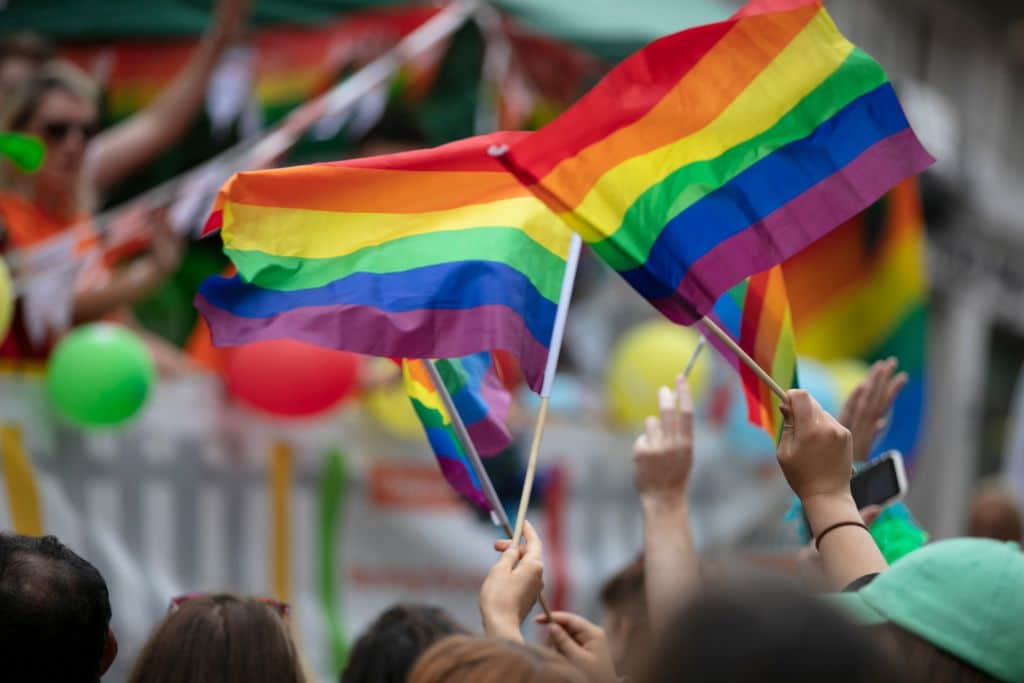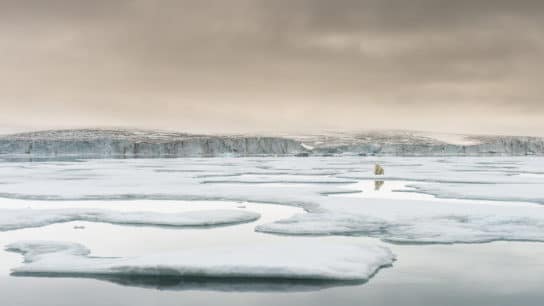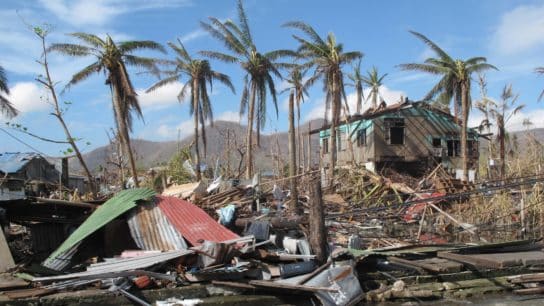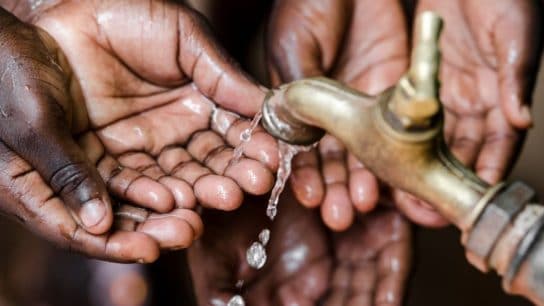Although the impact of the climate crisis will be universal, its effects will not be felt equally. While research shows that these communities are disproportionately impacted by climate change, LGBTQI+ subjectivities have been routinely invisible in mainstream discussions about those worst affected by climate disasters. Here are four examples of how LGBTQI+ people are more vulnerable to climate change.
—
4 Ways the Climate Crisis Impacts LGBTQI+ People
1. Discrimination of LGBTQI+ People in Disaster Relief
Evidence from past disasters has shown that the quotidian marginalisation experienced by queer and trans people is compounded when disaster strikes. Research on the impact of disasters on LGBTQI+ people in the United States found that they experience barriers to proper healthcare, difficulty accessing food and water rations, and securing emergency shelters after being displaced by environmental disasters.
This issue is not unique to the US. In many countries, the prevalence of legal discrimination towards sexual and gender minorities (SGMs) works to exclude these communities from accessing services in the aftermath of disasters.
Trans and intersex people displaced after the devastating earthquake that hit Haiti in 2010 reported being shut out of shelters, while LGBTQI+ people experienced routine harassment in camps by officials and other residents. Queer men receiving treatment for HIV/AIDS said that their ability to access this medicine was made difficult by the homophobia of medical staff on the ground; others reported being denied aid packages as same-gender couples because of the heteronormative articulations of the family in disaster response policies. There was also an escalation of extreme cases of violence including a lesbian being gang raped in the immediate aftermath and a woman who was beaten as she was pulled out of the rubble when it was discovered she was transgender.
Sadly, international disaster relief efforts have been woefully slow to act to recognise LGBTQI+ subjectivities. Experts in the field have criticised disaster responses for applying a “one size fits all” approach to disaster responses, and flattening diverse experiences of crises, with a 2021 report by disaster research and advocacy group DDR Dynamics on the issue from finding that “there is a continued failure, both at national and international level, regarding the recognition and inclusion of LGBTQI+ individuals within disaster policy and practice.”
2. Retributive Religious Violence
Religious persecution puts LGBTQI+ communities at risk of violence and death in the aftermath of environmental catastrophes. After earthquakes and hurricanes in New Zealand, Malaysia, the US, Israel, and Haiti, religious leaders told followers that these disasters were punishments from God for the prevalence of queer and trans people in society.
This led to increased rates of retributive sexual and physical violence towards SGM people. After the earthquake in Haiti, lesbian, gay, transgender, and bisexual people reported being physically attacked, sexually assaulted and even killed by those seeking retribution, with no protection offered by state officials who instead responded by increasing the rate of arrests and persecution towards SGMs.
This vulnerability is compounded by the destruction of community spaces by disaster, leaving LGBTQI+ people isolated and scattered in temporary camps and shelters.
3. Barriers to Safe Migration Routes
The knock-on effect of climate change on displacement is well documented. According to a report by the Intergovernmental Panel on Climate Change (IPCC), between 3.3 and 3.6 billion people are currently living in climate-vulnerable areas and the number is expected to keep rising as the climate crisis worsens.
The UN estimates that, out of the nearly 60 million people internally displaced in 2021, the majority were displaced because of climate-related disasters. According to the World Bank, the number of climate refugees will surpass 200 million people by 2050. Despite these staggering numbers, those displaced by climate change do not presently qualify for refugee status under international refugee law.
While LGBTQI+ people have reported experiencing violence and harassment on journeys to refugee camps after disaster, this is not the only way communities are disproportionately impacted. Although there is hope we are close to formally recognising climate refugees under international law, observers have detected a homogenising understanding of these groups in key international bodies that puts LGBTQI+ climate refugees at risk of further harm.
You might also like: Climate Migration Is the Crisis of the Century
One size fits all in climate asylum
In what was heralded a “landmark” case for climate asylum, the case of Teitiota v. New Zealand saw the UN Human Rights Committee determine that individuals who seek asylum as a result of climate change cannot be deported if these conditions violate the right to life. The claimant in question was from Kiribati, an island country in Oceania in the central Pacific Ocean that is already suffering significantly from climate change and is likely to be uninhabitable by 2100.
New Zealand rejected his claim on the grounds that there was not an immediate threat to life, noting that the effects of climate change in the region were “indiscriminate”. This ruling was upheld by the UN committee, who determined that the threat to life needed to be personal to the claimant and “cannot derive merely from the general conditions in the receiving state, except in the most extreme case.”
This qualifier throws up problems for future LGBTQI+ climate refugees.
“If courts view climate change as affecting everyone equally it is more difficult to justify why LGBTQI+ people are uniquely vulnerable to its effects” writes Eoin Jackson, Research Assistant at the Climate Governance Commission in an essay about this issue.
“They are either likely to bear the brunt of the loss of resources as the state diverts its attention to climate change, or experience the worst effects of the instability arising as a nation falls victim to environmental degradation.”
Heteronormative erasure in processes of family reunification
Of course, there are other routes to asylum for those displaced as a result of climate catastrophe. LGBTQI+ people can apply for refugee status via the family reunification route if they are sponsored by a family member who has secured refugee status in another country. However, this is made difficult for LGBTQI+ applicants, who are significantly more likely than cisgender heterosexual people to be estranged from their birth families.
While LGBTQI+ people have sought sanctuary and support in “chosen” families in their communities, processes of reunification in most countries, “relative” is interpreted narrowly; defined as immediate dependent blood, adopted or by marriage relatives. This works as a de-facto discrimination, excluding many LGBTQI+ people from accessing safe routes out of unsafe environments.
You might also like: Op-Ed: Listening to Those Most Impacted by Climate Change
4. Widening Inequalities
Climate change has been widely described as a “threat multiplier” because of its role in exacerbating existing socio-economic inequalities. Acting as both the cause and effect of climate vulnerability, these inequalities are escalating between the Global North and the Global South, as well as between groups in states themselves.
Due to their position at the margins of society, LGBTQI+ people are especially vulnerable to widening inequalities. Global trends show that LGBTQIA people are more likely to experience homelessness and insecure housing, alcohol and substance dependency, social and family violence, job insecurity and poverty. Concentrations of populations in poor urban areas means communities are exposed to greater risks of harm from air pollution, food and water insecurity, and rising urban temperatures.
Of course, this is not felt equally; women and gender variant people are particularly at risk from transphobic violence, as are queer women who are at greater risk of domestic violence and structural misogyny. LGBTQI+ people who experience structural racism, casteism, sexism and ableism in their countries are also acutely impacted.
Despite this grim reality, there is a dearth of focused research on what will be an escalating issue for groups made vulnerable by economic and political structures. Research from the Environmental Justice Foundation found that, although low-income, marginalised people are disproportionately impacted by the climate crisis, current policies are failing to account for these compounding vulnerabilities.
You might also like: How Marginalised Groups Are Disproportionately Affected by Climate Change
What Can We Do?
We are now well versed on the actions we need to undertake to mitigate the worst effects of climate change: urgently cutting our reliance on fossil fuels and radically transforming our present economic system from one that exploits and over-consumes, to one that sees all of humanity live according to their needs. But we must also ensure that climate and disaster responsive policies do not apply a homogenising lens when it comes to victims of climate-related catastrophes.
We need to be clear in our language: it is not just a nebulous “change” in the climate that puts LGBTQI+ people at greater risk of harm, but that with disaster comes an escalation of the marginalisation and persecution already present in many LGBTQI+ lives.
These issues are systemic. It would be foolish to talk about persecution towards LGBTQI+ in former colonies without talking about the theft of resources that accompanied Christian missionaries. The role of colonialism and market capitalism in the destruction of the environment cannot be extrapolated from the present-day conditions of LGBTQI+ across the Global South.
We need solutions that acknowledge this and are attentive to the ways in which history has also cemented in international crisis responses a reticence to account for LGBTQI+ subjectivities.
There are pathways already out there and organisations are slowly waking up to the need to address gaps in knowledge and response. Tangible steps forward could include rejecting an “add LGBTQ and stir” approach and instead building policy around LGBTQI+ experiences, providing additional funding for grassroots community groups in impacted areas, progressing LGBTQI+ specific research on the impacts of the climate crisis and engaging in collaborative pre-planning in climate vulnerable areas to ensure that LGBTQI+ people will be supported and protected in the event of environmental disasters.
There is no time for despair. As civil rights revolutionary Angela Davis reminds us, we must act as if it were possible to radically transform the world and we must do this all the time.
Let’s keep the pressure on our governments and decision makers on the climate to ensure that the development of climate related laws and policies are led by those most affected by climate catastrophe. Championing LGBTQI+ leadership is paramount to achieving this.
This story was originally published on June 13, 2023.
This story is funded by readers like you
Our non-profit newsroom provides climate coverage free of charge and advertising. Your one-off or monthly donations play a crucial role in supporting our operations, expanding our reach, and maintaining our editorial independence.
About EO | Mission Statement | Impact & Reach | Write for us














